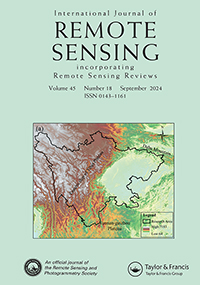Comparative study of remote sensing estimation methods for grassland fractional vegetation coverage - a grassland case study performed in Ili prefecture, Xinjiang, China
2019-01-01 null null 40(卷), null(期), (null页)
Fractional vegetation coverage (FVC) is an important biophysical parameter of terrestrial ecosystems. Based on Gaofen satellite no. 1 (GF-1) wide field-of-view (WFV) data from the Ili area of Xinjiang measured during the 2014 peak grassland vegetation season (from July to early August), this study adopted the statistical modelling, partitioned sub-pixel modelling, linear spectral unmixing, and maximum three-band gradient difference methods to estimate the FVCs of grasslands in the aforementioned region. The accuracies of the four estimation methods were compared and the effect of grassland type on accuracy was analysed. Based on ground quadrat data, the accuracies of the four methods of estimating grassland FVC in Xinjiang, Ili, were 88.66%, 87.31%, 88.01%, and 75.21%, respectively. The statistical modelling method was the most accurate, while the maximum three-band gradient difference method was the least. Temperate meadow steppe estimates developed using statistical modelling were the most accurate at 94.36%. The average accuracy of the four methods was highest when estimating temperate desert (90.10%) and the lowest accuracy was achieved with alpine meadow, with an average accuracy of 77.27%. Statistical modelling provided the highest accuracy in estimating the grassland FVC when adequate ground quadrat data was available, while the partitioned sub-pixel model had some advantages in estimating the low vegetation coverage area represented by temperate desert, and its precision reached 92.57%. Although the overall estimation accuracy of the maximum three-band gradient difference method was low, it achieved higher accuracy in the alpine meadow area than the other methods, reaching 85.62%.
关键词
相关推荐
- Estimation of crude protein content in natural pasture grass using unmanned aerial vehicle hyperspectral data [2019-01-01]
- The Spatiotemporal Dynamics of Vegetation Cover and Its Response to the Grain for Green Project in the Loess Plateau of China [2019-01-01]
- Assessment of grassland carrying capacity drivers and evaluation of pasture-livestock balance: A case study of Xinjiang, China [2019-01-01]
- The landscape altered the interaction between vegetation and climate in the desert oasis of Hotan River Basin, Xinjiang, China [2019-01-01]
- Dynamic monitoring of aboveground biomass in inner Mongolia grasslands over the past 23 Years using GEE and analysis of its driving forces [2019-01-01]



